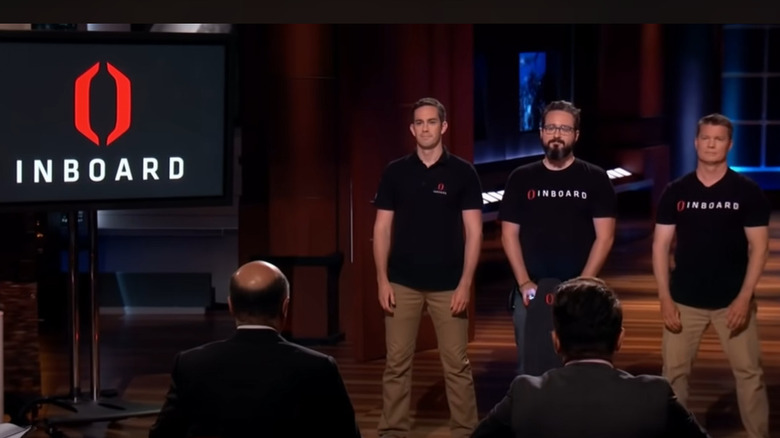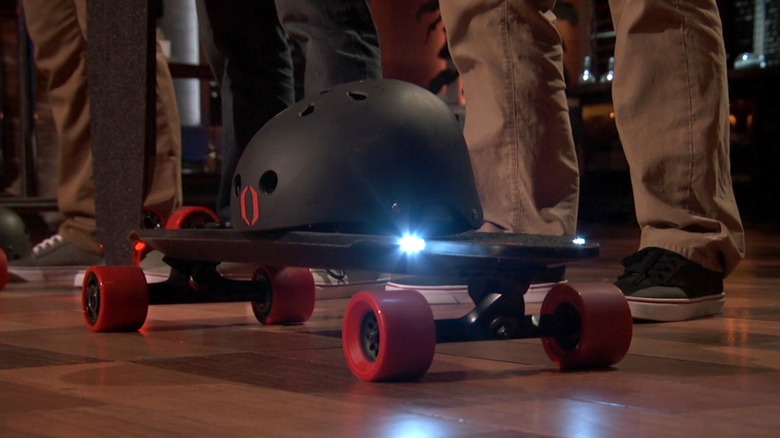What Happened To The Inboard M1 Electric Skateboard From Shark Tank Season 8?
One never really knows what they'll see when they tune into an episode of "Shark Tank." Whether the sharks are making million-dollar deals or making fools of wannabe entrepreneurs, fans who've kept up with the reality series over its 15-seasons-and-counting run can tell you it's always fascinating to watch the negotiations unfold.
It is, perhaps, even more interesting to see which products the sharks choose to invest in from one episode to the next, as even some of the more "sure-thing" types of investments sometimes struggle to strike a deal with the feisty panelists. That was just the case with a team of tech entrepreneurs who cruised into the "Shark Tank" studio during a Season 8 episode trying to coax the sharks into floating them close to $1 million in capital for a piece of Inboard, the company they'd built on the back of their innovative M1 Electric Skateboard.
It's been more than seven years since the owners of the Santa Cruz, California, company walked into the studio and made their pitch. Here's what happened to Inboard M1 after their fateful "Shark Tank" appearance.
What happened to Inboard on Shark Tank?
The Inboard ownership group was the first to pitch outgoing "Shark Tank" star Mark Cuban and his fellow panelists during the 10th episode of Season 8. They rode into the studio on their electric M1 skateboards, eyes set on securing a $750,000 investment. For that lofty sum of cash, they were offering a 4% stake in their company, and right off the bat, there seemed to be some legitimate interest, with Kevin O'Leary giddily volunteering to give the M1 a test ride himself.
That ride went better than most of the panel expected, with O'Leary openly admitting how much he liked the M1 as he disembarked. But as any "Shark Tank" fan knows, a panelist "liking" a product doesn't always mean they're interested in making a deal, and after putting their best pitch forward, Cuban, Robert Herjavic, and guest "Shark" Chris Sacca were quick to pass on Inboard. O'Leary, however, remained interested and offered to buy in with a $750,000 loan at 8% interest and a 2.5% equity stake. But his retail-connected "Shark Tank" counterpart Lori Greiner was also interested, offering the same deal as O'Leary, only at 3% equity.
Faced with a tough decision, the Inboard team stepped out of the studio to discuss it. That proved a tactical misstep, as O'Leary and Greiner cut a side deal while they talked, pitching Inboard a restructured opportunity upon their return. After some tricky negotiations, a deal was brokered, with Inboard securing a $750,000 loan at 9% interest and 4% equity.
What happened to Inboard after Shark Tank?
What initially turned the other "Shark Tank" panelists off Inboard's M1? Most were wary of investing in the product as the electric skateboard market was already pretty crowded. But tech sites like The Verge praised the M1's innovative in-wheel motor design and battery. Backed with solid financials, it seemed team Inboard had a hit on their hands before rolling into their "Shark Tank" pitch, and their plans to sell the board through major retail chains like Best Buy only sweetened the pot.
The "Shark Tank" exposure almost certainly gave Inboard a boost on the sales front, and there seemed little question the $750,000 investment would give the company the boost it needed to ramp up production. So, Inboard appeared to be on solid financial ground after its primetime debut, and the company soon found itself in a position to think about expanding its line of products beyond the popular M1 Electric Skateboard.
Unfortunately, the company could not keep the good times going. Things quickly went South for Inboard in 2019 after leadership made a multi-million dollar gamble on said new product, the G1 electric scooter. But Inboard's ambitious move to break into the electric scooter market proved trickier and more time-consuming than expected. After Inboard failed to produce its scooter in a timely manner, the by-then, over-leveraged company couldn't right the ship and was forced to not only lay off its employees but liquidate its intellectual property and assets.
What is next for Inboard?
Given how the electric scooter market has exploded, Inboard's desire to stake a claim seemed to make a lot of sense. There was also considerable consumer interest in their G1 Glider, with the company reportedly procuring around 1,500 pre-order deposits for the e-scooter after announcing it. Inboard had also received more than $8 million in additional funding prior to announcing the G1. But the company may have made a misstep in marketing the G1, opting to cancel pre-orders and refund deposits taken for the e-scooter when a deal to instead sell a fleet of G1s to a major player on the European scooter scene came into play.
As Inboard co-founder Ryan Evans told The Verge, the move was risky in terms of timing. Still, the company's financial backers assured they'd help keep the company operational until it could meet its production timeline on the fleet of G1s. Unfortunately, Evans claims the backing never materialized. Without it, the G1's development timeline proved too much for Inboard to bear financially. As the company was ultimately liquidated, it should go without saying that there will be no next for either Inboard or their magnificent M1 Electric Skateboard.



